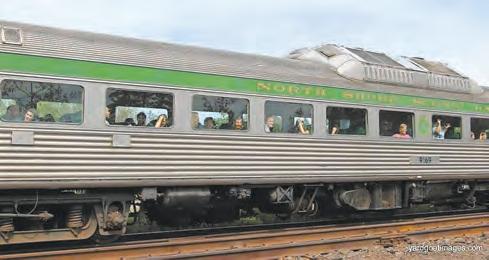
2 minute read
ADVANCEMENTS
continued from PAGE 14 of a high stakes game that both the Union Pacific and Central Pacific were playing to lay as much track as possible before Congress cut off their funding.
The Central Pacific reached there on April 30. However, the Californians would have to wait another week before the Union Pacific crew came into view.
By May 7 only 2500 feet of ungraded land lay between the two railroads. That afternoon CP President, and by then the governor of California, Leland Stanford pulled in on his private train for the next day’s celebration. Shortly after his arrival a representative of the Union Pacific told Stanford that the joining of the rails would have to wait three days until the 10th of May.
The delay was blamed on a washout blocking the train carrying UP Vice President Thomas Durant. Turns out that was just half of the story. On May 6, on his way to Promontory, Durant’s train was mugged by an armed mob of several hundred disgruntled workers who were demanding their back pay. They switched his car onto a sidetrack and chained it to the rails. Desperate telegraphs to nearby army bases for assistance were intercepted. The impasse was resolved when Durant finally surrendered and had the wages transferred from the railroad’s New York headquarters.
On the morning of the 10th the two engines recorded in that famous photo approached. A crowd of about 500-700 people, mostly workers, gathered in front of them. The actual pounding of the golden spike took only a few minutes before the dignitaries returned to their respective trains to continue the celebration in private. Meanwhile the rest of the country went crazy nuts.
The momentous finish was not only pounded down with gold and silver spikes but pounded out on brass. A telegrapher, by the name of Shilling, had all the lines cleared coast to coast when he used his brass key to tap out “Done” to a waiting nation.
In Chicago a “spontaneous” parade seven miles long jammed the streets. In Philadelphia flags were raised everywhere and the bells of Independence Hall chimed in with church bells from across the city. One hundred guns fired salutes in New York’s City Hall Park. In San Francisco the celebration “came into an uproar and lasted well into the night.”
But nowhere was the completion of the Transcontinental Railroad more widely triumphed than where it started in the California hometown of the Big Four of the CP, Sacramento.
“At Sacramento the bells and whistles of thirty assembled locomotives led the general chorus of all the bells and whistles of the city in one prolonged demonstration of joy.” — San Francisco Examiner 5/12/1869
From that reporter’s summation of joy and jubilation came the phrase that for then and now means an all-out, no holds, show of enthusiasm for a brand new triumph and success…..all the bells and whistles!
You know, if you work it hard enough, it all comes back to the railroad.
Sources:
“The Iron Horse” – The Impact of the Railroads on 19th Century American Society – Marieke Van Ophem; 19942012 GMW
San Francisco Examiner – 5/12/1869
New York Herald – 5/11/1869
Fairlex Dictionary of Idioms – 2015 Edition









